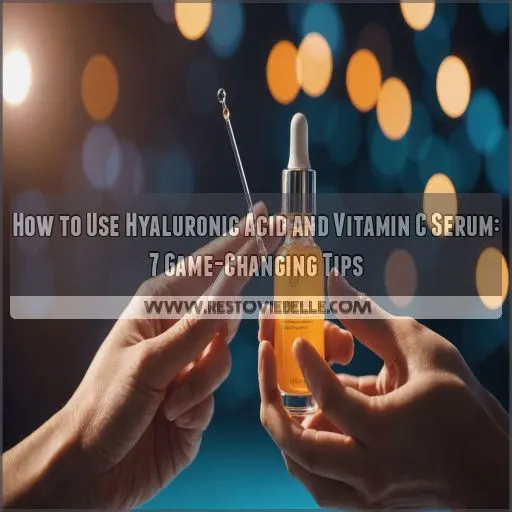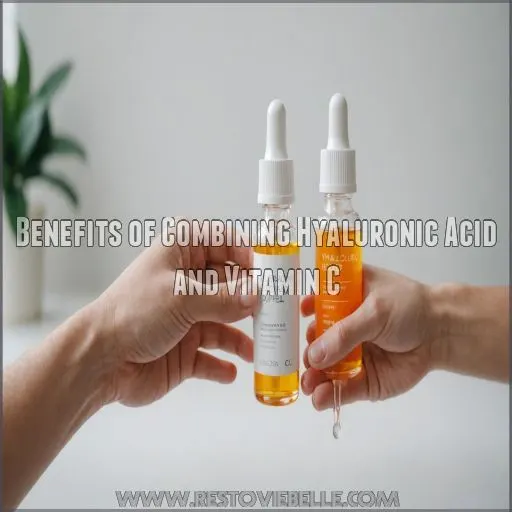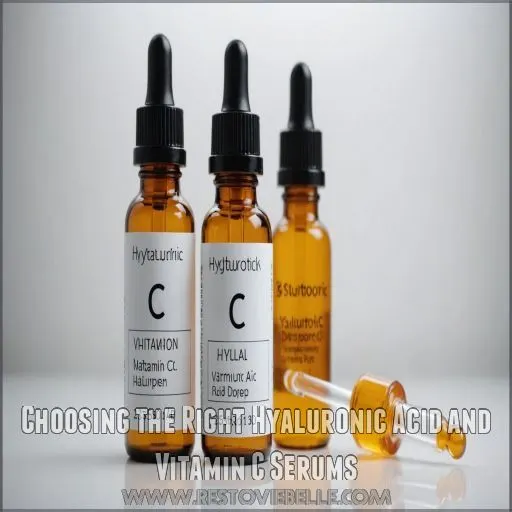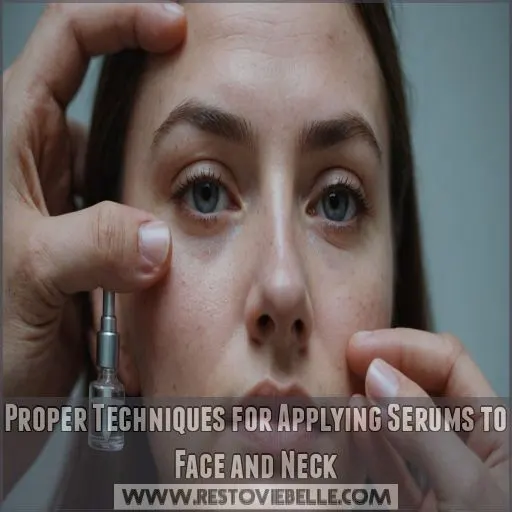This site is supported by our readers. We may earn a commission, at no cost to you, if you purchase through links.
 To maximize results when using hyaluronic acid and vitamin C serum, start with a clean, dry face.
To maximize results when using hyaluronic acid and vitamin C serum, start with a clean, dry face.
Apply vitamin C serum first due to its lighter consistency and lower pH—think of it as the opening act in your skincare concert. Give it a moment to absorb, then follow with hyaluronic acid, which acts like a moisture magnet, plumping your skin like a juicy grape.
Remember, a little goes a long way! Apply these serums in the morning for bright, bouncy skin all day.
Want to uncover how to integrate these into your routine like a skincare pro, just like a natural hair care expert using a hydrating leave-in conditioner therapy
? Keep reading!
Table Of Contents
- Key Takeaways
- Benefits of Combining Hyaluronic Acid and Vitamin C
- Hydration and Plumping Effects of Hyaluronic Acid
- Antioxidant and Brightening Properties of Vitamin C
- Synergistic Effects on Skin Health and Appearance
- Enhanced Protection Against Environmental Stressors
- Improved Collagen Production and Skin Elasticity
- Reduction in Fine Lines and Wrinkles
- Overall Skin Tone and Texture Improvement
- Choosing the Right Hyaluronic Acid and Vitamin C Serums
- Preparing Your Skin for Serum Application
- Proper Cleansing Techniques for Maximum Absorption
- Importance of Gentle Exfoliation Before Serum Use
- Toning to Balance Skin PH and Enhance Penetration
- Addressing Any Existing Skin Issues or Sensitivities
- Creating a Clean and Dry Canvas for Serum Application
- Considering the Use of Facial Steaming or Warm Compresses
- Timing Serum Application for Optimal Effectiveness
- Correct Order of Applying Hyaluronic Acid and Vitamin C
- Determining Which Serum to Apply First
- Timing Between Serum Applications for Best Results
- Techniques for Layering Multiple Serums Effectively
- Adapting Application Order Based on Product Consistency
- Considering Skin’s Natural PH and Product Formulations
- Maximizing Ingredient Absorption and Efficacy
- Adjusting Application Order for Different Skin Types
- Proper Techniques for Applying Serums to Face and Neck
- Correct Amount of Serum to Use for Each Application
- Gentle Patting Vs. Rubbing Techniques for Absorption
- Focusing on Specific Areas of Concern During Application
- Extending Serum Application to Neck and Décolletage
- Avoiding Common Application Mistakes and Pitfalls
- Incorporating Facial Massage for Enhanced Penetration
- Ensuring Even Distribution of Serums Across Skin Surface
- Integrating Serums Into Morning and Evening Skincare Routines
- Ideal Times for Using Hyaluronic Acid and Vitamin C
- Incorporating Serums With Other Skincare Products
- Adjusting Routines for Different Seasons and Climates
- Balancing Serum Use With Other Active Ingredients
- Considering Lifestyle Factors Affecting Serum Efficacy
- Adapting Routines for Travel and Special Occasions
- Developing Consistent Habits for Long-term Results
- Monitoring and Adjusting Serum Use for Best Results
- Observing Skin’s Response to Combined Serum Use
- Gradually Increasing Frequency and Concentration
- Addressing Potential Irritation or Sensitivity Issues
- Tracking Improvements in Skin Texture and Appearance
- Adapting Serum Use as Skin Needs Change Over Time
- Consulting With Skincare Professionals for Personalized Advice
- Combining Serums With Complementary Treatments for Enhanced Effects
- Frequently Asked Questions (FAQs)
- Can you use hyaluronic acid and vitamin C serum together?
- Which goes first vitamin C or hyaluronic acid?
- Should I use hyaluronic acid in the morning or night?
- Is it better to put vitamin C on wet or dry skin?
- Can sensitive skin use these serums together?
- Do these serums help reduce acne marks?
- What is the ideal storage condition for serums?
- How long to see results with these serums?
- Are these serums safe during pregnancy?
- Conclusion
Key Takeaways
- Layer your serums like a pro – start with vitamin C to brighten and protect, then follow up with hydrating squalane moisturizing creams for a skin-quenching boost
.
- Prep your skin for maximum absorption by cleansing gently, exfoliating lightly, and toning to balance your skin’s pH – it’s like rolling out the red carpet for your serums.
- Adjust your routine for different seasons and skin types – your skin is unique, so be willing to experiment to find the perfect serum combination that makes it glow.
- Consistency is key – stick to your serum routine, track your progress, and you’ll be on your way to achieving that coveted "glass skin" look in no time.
Benefits of Combining Hyaluronic Acid and Vitamin C
You’re about to discover the powerful skincare duo that’ll transform your complexion.
Combining hyaluronic acid and vitamin C in your routine can bring you a world of benefits.
From plumper, more hydrated skin to a brighter, more even-toned appearance.
Hydration and Plumping Effects of Hyaluronic Acid
Thirsty skin? Hyaluronic acid is your skin’s tall drink of water. This moisture-magnet molecule can hold up to 1,000 times its weight in water, giving your complexion a serious hydration boost.
- Infuses all skin layers with rejuvenating moisture
- Binds water to skin cells, increasing hydration
- Prevents overproduction of oil in acne-prone skin
- Promotes proper moisture balance for a clearer complexion
Say goodbye to parched skin and hello to a plump, dewy glow!
Antioxidant and Brightening Properties of Vitamin C
Vitamin C isn’t just for your morning juice – it’s a skin care powerhouse too. This antioxidant superhero fights off pesky free radicals that age your skin . But that’s not all – it’s also your secret weapon for a brighter, more even complexion.
Check out these vitamin C superpowers:
| Benefit | How it works | Result |
|---|---|---|
| Antioxidant | Neutralizes free radicals | Prevents premature aging |
| Brightening | Inhibits melanin production | Fades dark spots |
| Collagen boost | Promotes collagen synthesis | Improves skin firmness |
| Sun protection | Enhances UV defense | Reduces sun damage |
Synergistic Effects on Skin Health and Appearance
When you combine hyaluronic acid and vitamin C, you’re in for a skincare treat! These powerhouse ingredients work together like a dream team, creating a synergy that’ll have your skin singing.
- Plump up fine lines and wrinkles
- Boost collagen production for firmer skin
- Even out skin tone and texture
- Give you that coveted "glass skin" glow
Talk about a one-two punch against aging!
Enhanced Protection Against Environmental Stressors
Your skin’s up against a daily barrage of environmental baddies.
But don’t sweat it! Hyaluronic acid and vitamin C team up to create a powerful defense shield.
These dynamic duo antioxidants work overtime to neutralize free radicals, fend off UV damage, and protect against pollution (Source).
It’s like giving your skin its own personal bodyguard, ready to tackle whatever the world throws its way.
Improved Collagen Production and Skin Elasticity
Combining hyaluronic acid and vitamin C isn’t just about protection – it’s a powerhouse duo for boosting your skin’s natural collagen production.
This dynamic pair works together to give your skin that youthful bounce and firmness you’ve been dreaming of.
Vitamin C is a key player in collagen synthesis, while hyaluronic acid helps create the perfect environment for your skin to thrive.
It’s like giving your skin a much-needed pep talk to give it that youthful bounce and firmness.
Reduction in Fine Lines and Wrinkles
Collagen production isn’t the only trick up your skincare sleeve. The dynamic duo of hyaluronic acid and vitamin C also works wonders on those pesky fine lines and wrinkles.
- Hydration plumps up skin cells
- Antioxidants fight off free radical damage
- Vitamin C boosts natural collagen synthesis
- Hyaluronic acid improves skin elasticity
It’s like giving your skin a revitalizing drink and a protective shield all at once!
Overall Skin Tone and Texture Improvement
The dynamic duo of hyaluronic acid and vitamin C doesn’t just fight wrinkles—it’s your ticket to a total skin makeover.
You’ll notice a more even tone and smoother texture, giving you that coveted "lit from within" glow.
Let’s break down the magic:
| Benefit | Hyaluronic Acid | Vitamin C | Combined Effect |
|---|---|---|---|
| Tone | Hydrates | Brightens | Even complexion |
| Texture | Plumps | Exfoliates | Smoother surface |
| Radiance | Moisturizes | Protects | Healthy glow |
| Long-term | Retains water | Builds collagen | Youthful resilience |
These powerhouses work in tandem to tackle inflammation, shield against damage, and reveal your skin’s true potential.
Choosing the Right Hyaluronic Acid and Vitamin C Serums
You’re ready to supercharge your skincare routine with hyaluronic acid and vitamin C.
Let’s break down how to select high-quality formulations that’ll give your skin the glow-up it deserves, without any confusing jargon or snake oil promises.
Identifying High-quality Hyaluronic Acid Formulations
If you’re looking for a great hyaluronic acid (HA) serum, here’s what to look for:
- Molecular weight variety (small, medium, and large molecules)
- HA concentration between 0.5% and 2%
- Ingredient list free of potential irritants
- Positive product reviews from reputable sources
- Brand reputation for quality skincare
Remember, higher price doesn’t always mean better quality. Some budget-friendly options pack a serious hydration punch!
Selecting Stable and Effective Vitamin C Serums
Three key factors determine a stable and effective vitamin C serum: form, concentration, and packaging.
L-ascorbic acid packs the biggest punch but can be unstable . Aim for serums with 10-20% concentration for the best results without irritation. Look for dark or opaque bottles to protect against light degradation.
| Factor | What to Look For | Why It Matters |
|---|---|---|
| Form | L-ascorbic acid | Most potent |
| Concentration | 10-20% | Effective, low irritation |
| Packaging | Dark/opaque bottle | Protects stability |
Considering Skin Type and Specific Concerns
Now that you’ve nailed down your Vitamin C pick, let’s match your serums to your skin’s unique needs. Your skin type is like your personal skincare GPS, guiding you to the perfect products, like choosing the right toner for your skin type
.
- Sensitive skin: Look for gentle, fragrance-free formulas
- Oily or acne-prone: Opt for lightweight, non-comedogenic options
- Dry or aging skin: Choose serums with added moisturizing ingredients
- Hyperpigmentation: Seek formulations with brightening agents like Kakadu Plum
Remember, your skin is as unique as you are!
Evaluating Concentration Levels for Optimal Results
Choosing the right concentration levels can make or break your skincare routine.
For vitamin C, look for serums with 10-20% L-ascorbic acid for maximum effectiveness .
Hyaluronic acid concentrations vary, but 1-2% is typically ideal for most skin types.
Remember, higher isn’t always better – your skin’s sensitivity matters.
Start low and gradually increase to find your sweet spot.
It’s like finding the perfect recipe for your skin’s unique appetite to determine the maximum effectiveness.
Examining Additional Ingredients and Their Benefits
When selecting your power duo of hyaluronic acid and vitamin C serums, don’t overlook the supporting cast.
Niacinamide can help even out skin tone, while retinol boosts collagen production.
Peptides are like tiny cheerleaders for your skin cells, encouraging them to perform better.
Ceramides lock in moisture, and antioxidants provide extra defense against environmental stressors.
These ingredients work synergistically to amplify the benefits of your main stars, creating a supporting cast.
Assessing Product PH Levels for Compatibility
Three key factors determine whether your hyaluronic acid and vitamin C serums play well together: their pH levels, your skin’s sensitivity, and potential ingredient interactions.
To make sure they’re compatible, grab some pH strips and test your products .
Aim for vitamin C serums with a pH of 2.6-3.2 for the best absorption.
Remember, hyaluronic acid isn’t actually acidic, so it’s generally safe to pair with vitamin C. When in doubt, perform a patch test before diving in!
Preparing Your Skin for Serum Application
You’ve got your hyaluronic acid and vitamin C serums ready, but hold up—prepping your skin is key to maximizing their power.
By following a few simple steps before applying these powerhouse ingredients, you’ll create the perfect canvas for maximum absorption and effectiveness.
Proper Cleansing Techniques for Maximum Absorption
Diving into your skincare routine, proper cleansing is the foundation for maximum serum absorption.
Start by washing your face with lukewarm water to open up those pores. Choose a gentle, pH-balanced cleanser that won’t strip your skin of its natural oils.
For example, if you’re planning to use a hyaluronic acid serum, you’ll want to make sure your cleanser won’t interfere with its hydrating properties.
Remember, your face isn’t a dirty dish – no need to scrub! Instead, use circular motions to massage the cleanser, removing impurities without irritating your skin.
Importance of Gentle Exfoliation Before Serum Use
Gentle exfoliation is your secret weapon for supercharging serum absorption. By sloughing off dead skin cells, you’re paving the way for hyaluronic acid and vitamin C to work their magic.
- Unclogs pores, allowing serums to penetrate deeper
- Evens out skin tone for a brighter complexion
- Stimulates cell turnover, boosting the effectiveness of anti-aging ingredients
Think of it as rolling out the red carpet for your skincare VIPs. Your skin will thank you!
Toning to Balance Skin PH and Enhance Penetration
Picture your skin as a delicate ecosystem — toning is like creating the perfect climate for your serums to thrive.
After cleansing, sweep a pH-balancing toner across your face to prep the canvas. This step isn’t just pampering; it’s science in action.
By adjusting your skin’s pH, you’re rolling out the red carpet for hyaluronic acid and vitamin C, ensuring they can penetrate deeply and work their magic.
Addressing Any Existing Skin Issues or Sensitivities
Before diving into your serum routine, it’s essential to address any existing skin issues. Think of your face as a canvas – you want it primed and ready for the masterpiece to come.
- Identify active breakouts or irritation
- Assess any dryness or flakiness
- Note areas of sensitivity or redness
- Consider recent sun exposure
- Evaluate any allergic reactions to products
By tackling these concerns first, you’ll set the stage for the best serum absorption and effectiveness.
Creating a Clean and Dry Canvas for Serum Application
Alright, you’ve addressed your skin issues; now let’s set the stage for applying serums.
Start with a thorough cleansing routine to remove oils and impurities, making way for effective absorption.
Think of it like rolling out the red carpet for your serums.
Exfoliate gently for added glow, then apply toner to balance pH and prepare your skin for hydration; this is essentially preparing your skin.
Considering the Use of Facial Steaming or Warm Compresses
Creating a clean canvas is like setting the stage for your star serums. Consider facial steaming or warm compresses before applying products to enhance absorption. Steaming benefits include increased circulation and hydration, but avoid overdoing it to prevent dryness (Source). Warm towels can offer similar pre-serum prep perks with fewer risks.
- Feel refreshed
- Boosts serum absorption
- Eases tension away
- Invigorates the senses
- Empowers your skincare routine
Timing Serum Application for Optimal Effectiveness
Facial steaming sets the stage for your serum routine.
When thinking about timing, consider using vitamin C in the morning—it’s like your skin’s coffee to wake it up and protect against free radicals.
Hyaluronic acid works wonders any time, hydrating and plumping your skin.
Find what works best for your individual needs and skin type for the best results.
Correct Order of Applying Hyaluronic Acid and Vitamin C
To get the most out of your skincare routine, knowing the correct order to apply vitamin C and hyaluronic acid serums is really important.
Think of it like making your morning coffee: you wouldn’t add milk before brewing the coffee!
Determining Which Serum to Apply First
After prepping your skin, it’s time to decide which serum to grab first.
Start with the vitamin C serum due to its lighter consistency and lower pH, optimizing it for maximum absorption .
Think of it as laying the foundation; let it penetrate before layering hydrating hyaluronic acid.
Your skin will look more radiant and plump!
Timing Between Serum Applications for Best Results
Timing between serum applications isn’t rocket science, but it can feel like it.
To get the best results, wait a few minutes after applying your Vitamin C serum before reaching for the hyaluronic acid.
This absorption order helps each product work its magic, allowing you to cherish your newfound radiant skin.
Techniques for Layering Multiple Serums Effectively
When layering serums, apply the thinner, water-based formula first, like a hyaluronic acid serum, to allow maximum absorption.
Then, follow with a thicker, oil-based vitamin C serum.
This technique helps each ingredient effectively penetrate your skin without interference.
Adjust the order based on your skin type and product consistencies for the best results.
Adapting Application Order Based on Product Consistency
Ever wondered about serum consistency? Getting the application order right can be a game-changer, especially when using products like Hyaluronic Acid Serum, which can hold up to 1,000 times its weight in water.
When using hyaluronic acid, you need to apply it correctly to maximize its hydrating power and ability to retain moisture.
- Apply Lighter Serums First: Thin, watery serums like hyaluronic acid should go on first to quench your skin’s thirst.
- Layer Thick Serums After: Follow with thicker, creamier vitamin C serums to lock in moisture.
- Watch Product Synergy: They work together like a dream!
Considering Skin’s Natural PH and Product Formulations
Think of your skincare routine as a carefully crafted playlist.
Start with vitamin C, which has a lower pH, to brighten and protect. Then, layer hyaluronic acid to draw in moisture and create harmony between the two.
This application order respects your skin’s natural pH balance, ensuring ingredient synergy and product compatibility for glowing results.
Maximizing Ingredient Absorption and Efficacy
Achieving maximum absorption and efficacy of your serums is key. Layering correctly boosts results—apply your Vitamin C serum first, then follow with hyaluronic acid. Why? Vitamin C works at a lower pH, making your skin more receptive to hydration.
These factors are crucial to get the most out of your skincare routine. Remember these tricks:
- Serum consistency matters
- Watch your skin’s pH
- Product layering is important
- Time your application
- Use the right concentration
Adjusting Application Order for Different Skin Types
Figuring out your skincare routine can feel like a dance.
For sensitive skin, start with hyaluronic acid to soothe before vitamin C.
Oily skin might flip the script—vitamin C first helps control sebum in best toners for oily skin
.
Dry skin benefits from the hydrating hug of hyaluronic acid first, just like how using a good beard oil can help soften the skin underneath
.
Combination and mature skin can mix and match based on daily needs.
Proper Techniques for Applying Serums to Face and Neck
Applying serums to your face and neck is a bit like adding the perfect toppings to a sundae—it’s all about technique to get the best results.
Use the right amount and gentle patting instead of rubbing, and your skin will drink it up like a cool drink on a hot day, which will make it feel like a cool drink.
Correct Amount of Serum to Use for Each Application
For serum drop size, typically a pea-sized amount suffices, yet this can vary with skin type factors and individual needs. Adjust based on product consistency and usage frequency.
- For oily skin, you might need less.
- Dry skin? Perhaps a bit more.
- Bright and dewy? Just right!
- A touch of experimentation!
Gentle Patting Vs. Rubbing Techniques for Absorption
After deciding on the right serum amount, consider how you apply it.
Patting is like that gentle hug you didn’t know your skin needed—encouraging absorption while respecting skin sensitivity.
Rubbing can lead to unwanted friction and stretchiness.
Let your pores soak it up like a thirsty sponge! Apply based on serum consistency and product type for best results.
Focusing on Specific Areas of Concern During Application
Instead of rubbing, try gently patting your serums onto areas that need love, like those fine lines, dark circles, or acne scars.
Imagine you’re coaxing your skin into absorbing all that goodness. Focus on uneven tone or hyperpigmentation with a little extra attention.
Your skin’s like a sponge – be gentle but persistent, optimizing absorption for maximum impact.
Extending Serum Application to Neck and Décolletage
Incorporating neck and décolletage care into your routine isn’t just a neck wrinkle fix—it’s embracing skin health all the way.
Gently apply your serum with an upward motion, advocating for sun protection with every pat .
Imagine painting on strength and elasticity, one brushstroke at a time.
It’s science-backed art, keeping skin aging gracefully at bay.
Avoiding Common Application Mistakes and Pitfalls
Even the best of us can slip up when applying serums. Here’s the catch:
- Timing is key: Give each serum time to absorb before moving on.
- Avoid mixing: Layer instead of blending serums directly.
- Mind product consistency: Apply lighter serums first.
- Watch for ingredients: Check compatibility for irritation.
Incorporating Facial Massage for Enhanced Penetration
Imagine this: you’re pampering your skin with a DIY massage routine using clever facial massage techniques.
Gently glide your fingers or a massage tool in upward strokes, boosting serum absorption and promoting lymphatic drainage.
This ritual enhances the massage benefits but also adds a touch of zen to your skincare routine—a delightful blend of self-care and science .
Ensuring Even Distribution of Serums Across Skin Surface
When applying serums, imagine whisking your fingertips across a canvas, ensuring even strokes.
Master this art using these techniques:
- Use gentle fingertip pressure for best absorption.
- Employ circular massage methods to spread evenly.
- Adapt to your serum’s consistency; lighter serums cover more easily.
- Trust in the serum’s magic—let science, not serendipity, guide you.
Integrating Serums Into Morning and Evening Skincare Routines
Incorporating hyaluronic acid and vitamin C serums into your morning and evening routines is key for maximizing their skin-transforming benefits.
From adjusting your regimen for different seasons to balancing these potent ingredients with your other products, we’ll give you some tips from our experts.
Ideal Times for Using Hyaluronic Acid and Vitamin C
To rejuvenate your skin, consider starting your morning routine with vitamin C serum; its radiant glow protects against daytime environmental stressors. Using a product like hypoallergenic hyaluronic acid that’s suitable for all skin types can make a significant difference in your skincare routine.
In the evening routine, apply hyaluronic acid to boost hydration and repair your skin overnight, as it’s known for its intense skin hydration and anti-aging properties.
Remember, adjusting for seasonal changes and skin types is key—your skin will thank you for the thoughtful timing!
Incorporating Serums With Other Skincare Products
Think of your skincare routine as a harmonious symphony, where serum order and product layering fine-tune your skin’s future.
Start with Vitamin C, which brightens and protects, then follow with Hyaluronic Acid for deep hydration.
For sensitive skin, keep an eye on active ingredient combos to avoid any unwanted reactions.
Tweak routines, finding what feels best for your unique canvas!
Adjusting Routines for Different Seasons and Climates
Integrating serums with other skincare essentials is only part of the equation.
Adjust your routine as climates shift. Humidity can impact serum absorption, so embrace lighter products in sticky summers and richer creams as winter dryness kicks in.
Don’t skimp on sun protection even on cloudy days. Think of your skin like a delicate ecosystem responding to seasonal changes.
Balancing Serum Use With Other Active Ingredients
When balancing serum use with other active ingredients, mixing skincare feels like orchestrating a symphony.
Make sure ingredient compatibility; let hyaluronic acid play nicely with vitamin C. Retinol and vitamin C can make beautiful music, but consider serum layering order and AHA/BHA timing for harmony.
Experiment with product recommendations, mixing wisely without clashing notes for glowing, harmonious skin.
Considering Lifestyle Factors Affecting Serum Efficacy
You’ve got your serums balanced with other actives; now let’s factor in lifestyle.
Your skin’s best friend? A healthy diet, quality sleep, minimizing stress, and regular exercise.
But don’t forget the environment. These elements can tweak your skin’s response to serums.
Think of it as skincare jazz—each note matters for a harmonious symphony of effects, like a delicate balance of a healthy diet.
Adapting Routines for Travel and Special Occasions
Travel plans shaking up your skincare routine? Keep your serums in tow with these tips:
- Opt for travel-size products within TSA guidelines to simplify packing.
- Use resealable bags to prevent spills—serums are like escape artists.
- Customize routines for special events, focusing on hydration and brightness.
- Streamline to hyaluronic acid in the morning, vitamin C at night for convenience.
Developing Consistent Habits for Long-term Results
Developing consistent habits is key for seeing long-term results with hyaluronic acid and vitamin C serums.
Set reminders, keep your products visible, and celebrate small wins.
Tracking your progress can also motivate you to stick with your routine.
Remember, consistency trumps perfection – just keep showing up, and your skin will thank you. (Source)
Monitoring and Adjusting Serum Use for Best Results
To get the most out of your hyaluronic acid and vitamin C serums, it’s essential to pay attention to how your skin responds and make any necessary tweaks.
Think of your skincare routine like a relationship—sometimes you need a little adjustment to keep things working smoothly.
Especially if you notice love-hate signals from your complexion, it highlights the need for these adjustments to keep your skincare routine working effectively.
Observing Skin’s Response to Combined Serum Use
As you seamlessly blend hyaluronic acid and vitamin C into your routine, channel your inner detective to observe your skin’s response.
Notice hydration boosts, smoother texture, or unexpected reactions like sun sensitivity or breakouts.
Imagine your skin as a drama queen—sometimes dramatic changes signal success, while subtle shifts indicate long-term impact.
Keep an eye on these clues for ultimate skin satisfaction by watching for hydration boosts.
Gradually Increasing Frequency and Concentration
Your skincare journey is unique, like everyone else’s fingerprints.
To elevate results, consider how you can gradually up the ante by increasing frequency and concentration. Start small, giving your skin time to adjust.
- patch test first: Makes sure products suit your individual needs.
- Increase slowly: Layer products wisely.
- Watch for changes: Sensitivity concerns might vary.
Addressing Potential Irritation or Sensitivity Issues
You’re embracing freedom by tailoring your routine!
To sidestep irritation with serums, start with a patch test. Not all skin types react the same; it’s like cats with cucumbers—unexpected. Check product pH and practice gentle application by timing it right.
| Factor | Recommendation |
|---|---|
| Patch Testing | Always |
| Skin Type | Sensitive care |
| Product pH | Balance is key |
This measured approach helps keep your skin happy! .
Tracking Improvements in Skin Texture and Appearance
It’s fun to track your skincare journey.
Capture a "Before & After" photo log to visualize progress.
Routine tweaks help you reach those skincare goals.
Imagine pairing a progress tracker with a daily diary entry: "Woke up, skin glowing like a sunrise!"
Let these tools guide you in celebrating small wins and understanding how serums enhance your skin, using a progress tracker with a daily diary entry.
Adapting Serum Use as Skin Needs Change Over Time
Skincare routines often need a tweak as your skin changes with age or seasons.
Swap products to suit your skin’s thirst for moisture or battle-weary wrinkles.
Try lighter serums in summer and richer ones in winter—it’s like dressing your skin wardrobe!
Don’t be afraid to experiment with new products; just remember to patch test first to avoid surprises.
Consulting With Skincare Professionals for Personalized Advice
Consulting a skincare professional can be a game-changer for maximizing your serum routine.
They’ll assess your unique skin needs, recommend the right products, and guide you on proper application techniques.
Follow their advice on gradually introducing new ingredients and monitoring for irritation, and adjusting your regimen as your skin evolves over time.
Combining Serums With Complementary Treatments for Enhanced Effects
One fun avenue to explore? Adding complementary treatments to your serum routine.
Picture a facial massage enhancing absorption or LED therapy working magic on those fine lines.
Pair with retinol or slip on a sheet mask for hydration.
Consider microneedling for deep product penetration.
Mix and match—your skin’s playground awaits!
Frequently Asked Questions (FAQs)
Can you use hyaluronic acid and vitamin C serum together?
Mix hyaluronic acid and vitamin C serum as if it’s a skincare cocktail party—everyone (except maybe your skin) is invited!
Together, they hydrate, brighten, and protect, creating a synergistic blend for youthful, glowing skin.
Which goes first vitamin C or hyaluronic acid?
Apply your vitamin C serum first for that radiant glow, giving it time to absorb and work its magic.
Then, layer on hyaluronic acid to lock in moisture like a soft blanket of hydration.
Should I use hyaluronic acid in the morning or night?
Use hyaluronic acid both morning and night. It hydrates your skin, keeping it plump and radiant.
In the morning, pair it with SPF for protection, and at night, let it work its magic while you sleep.
Is it better to put vitamin C on wet or dry skin?
Applying vitamin C serum to damp skin is the way to go – it helps the potent antioxidant penetrate more effectively.
Just make sure to pat your face dry after cleansing before smoothing on that brightening goodness.
Can sensitive skin use these serums together?
Think of your skin as a delicate painting.
Yes, you can use hyaluronic acid and vitamin C serums together.
Opt for gentle formulations with lower vitamin C concentrations (around 10%) to avoid irritating sensitive skin.
Do these serums help reduce acne marks?
Hyaluronic acid and vitamin C serums can help reduce acne marks.
Vitamin C brightens dark spots and promotes collagen production, while hyaluronic acid hydrates and supports healing.
Together, they’re like a dynamic duo for clearer skin.
What is the ideal storage condition for serums?
Store your serums in a cool, dark place, like a cabinet, to keep them stable.
Avoid sunlight, which can degrade ingredients like Vitamin C.
A fridge is ideal for longer shelf life—think of it as a spa for your serums!
How long to see results with these serums?
You might see a swift skin splash with instant hydration from hyaluronic acid, but vitamin C’s vibrant effects can take 3 weeks to 3 months to fully flourish.
Fighting fine lines and fading dark spots with glycolic acid pads
.
Are these serums safe during pregnancy?
Pregnancy doesn’t mean giving up your skincare routine.
Vitamin C and hyaluronic acid serums are generally safe to use during pregnancy.
They offer benefits without significant risks, making them great companions on your pregnancy journey .
Conclusion
Think of your skincare routine as a well-composed symphony, with hyaluronic acid and vitamin C serums playing star roles.
By mastering how to use hyaluronic acid and vitamin C serum, you’ve tapped into their powerful synergy, crafting a vibrant and youthful appearance.
Like a maestro, balance each note—adjust application techniques and timing for your unique skin.
Keep an eye on the mirror; it’s your guide to achieving glowing results that’ll keep you center stage in your skincare journey.












